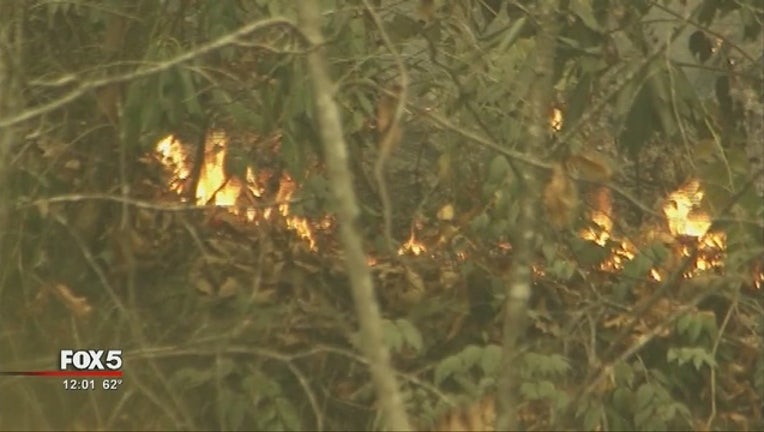Q&A: A look at wildfires burning in parched Southern states

CHARLOTTE, N.C. (AP) — Thousands of firefighters are battling wildfires across the drought-stricken South with little indication they'll get help from the weather any time soon. Here's a look at the current situation:
___
WHAT IS THE LATEST WITH THE SOUTHERN WILDFIRES?
Adam Rondeau, spokesman for the U.S. Forest Service, said Monday that the agency is tracking 33 wildfires totaling about 80,000 acres across the South.
Rondeau said some fires are up to 75 percent contained, while others may be only 15 percent contained, depending on ground conditions and what's fueling the fire.
The largest are Georgia's Rough Ridge fire, which has consumed 19,411 acres, and North Carolina's Tellico fire, which covers approximately 13,676 acres. Other fires are being reported in Kentucky, South Carolina and Tennessee.
About 5,000 federal, state and local firefighters are trying to knock the flames down.
"With the dry conditions as they are, this is a long-term response effort," Rondeau said. "This isn't going to happen in a couple of days. We're going to be looking at weeks."
___
WHAT IS THE DROUGHT SITUATION IN THE SOUTH?
The U.S. Drought Monitor reports that much of the South got precipitation last week but not enough to quench wildfires or replenish reservoirs.
Drought-stricken areas of Alabama and Georgia recorded temperatures up to 10 degrees warmer than normal and precipitation at or near zero, according to the latest report filed Nov. 8.
The report said abnormal dryness and moderate drought expanded in South Carolina. There was also deterioration of drought conditions in western North Carolina, while abnormally dry conditions were reported in parts of western Virginia and in the Florida Panhandle.
All of Kentucky is in moderate to severe drought, as is Tennessee except for its southeastern corner, which shows extreme or exceptional drought.
___
IS THERE ANY RELIEF FOR THE AFFECTED AREAS?
Joshua Palmer, National Weather Service meteorologist in Greenville-Spartanburg, South Carolina, said there no significant rain has fallen across the fire-stricken Southeast because very few moisture-bearing systems have come through the region since late August.
Palmer said that, since late August, what few weather systems have come through have been very dry because there hasn't been a prolonged period of moisture flowing from the ocean.
The forecast provides very little hope for the next two weeks, Palmer said.
"We really don't see any significant change to that overall concept where we have these cold fronts come through. They change the wind, they change the temperatures, they maybe dry us out in terms of dew points or relative humidity, but in terms of actual rainfall, they produce very little," Palmer said.
___
WILL WINTER BRING THE NEEDED PRECIPITATION?
Palmer said the outlook for the region going into winter calls for below-normal precipitation, which he blames on La Nina and is expected to persist into mid-winter. But he also says a precise forecast is difficult at this point.
Typically, he said, widespread rainfall occurs in December, January and February, but even with the current forecast, he isn't ruling out the prospect that precipitation will arrive.
"The signal is definitely mixed for our area," Palmer said. "We're going to remain cautiously optimistic, but it is very dry and it's not going to get any better any time soon."
Palmer added that if the rains don't come in the winter, bigger problems could develop heading into spring and summer.
"If we do not see any significant rainfall or we see below normal rainfall this winter, then going into the spring and summer, the drought conditions could intensify over the summer next year as the rainfall becomes more scattered and water usage increases," he said.
___
HOW IS THE AIR QUALITY?
The North Carolina Air Quality Forecast Center listed 18 counties in western North Carolina as having unhealthy air for Tuesday.
The latest forecast also said three more counties in the extreme southwest corner of the state were listed as very unhealthy and another 11 counties were designated as unhealthy for sensitive groups. Another 22 counties listed as good Monday were forecast to experience moderate air quality Tuesday.
Division of Air Quality meteorologist Elliot Tardif said winds coming out of the west or west-northwest Tuesday is expected to push smoke to the east. Tardif also said a low pressure system will skirt the North Carolina coast but the rain from it won't impact the wildfires.
In Georgia, air quality in the Atlanta area was rated as unhealthy for sensitive groups. The Georgia Department of Natural Resources said people with heart or lung disease, older adults and children should reduce prolonged or heavy exertion. Atlanta is about 80 miles south of the Rough Ridge fire, and smoke from various fires was drifting over the city.

